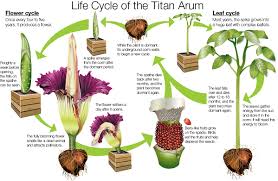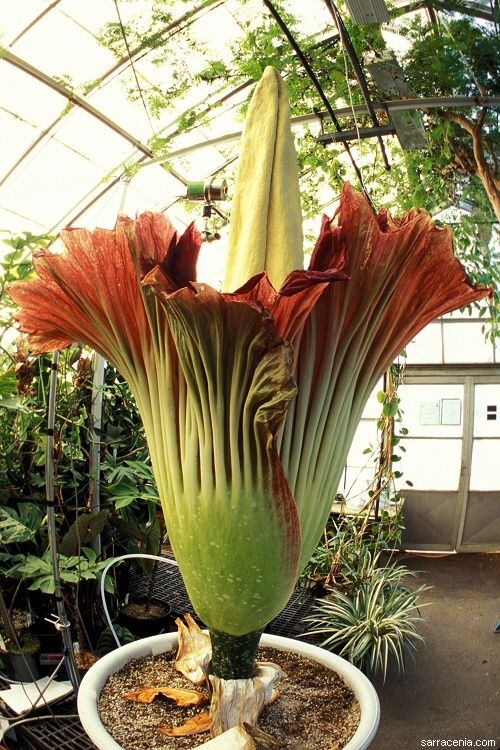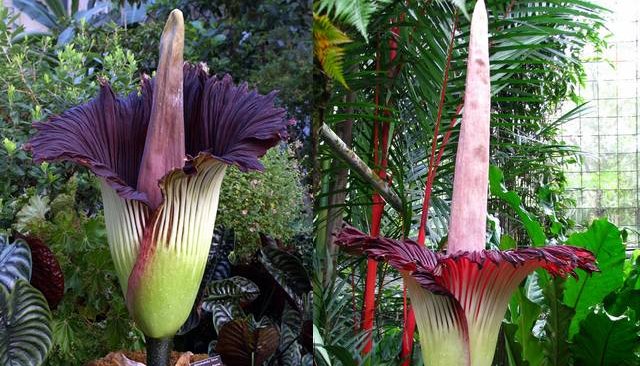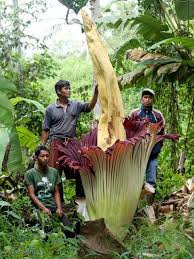Amorphophallus titanum
Amorphophallus titanum

Amorphophallus titanum, popularly known as the "corpse flower," is the world's biggest and worst smelling flower. Native to the Borneo rain forest, the plant blooms only a few times in its 40-year life span. During the first eight hours, the bloom emits a scent similar to rotting eggs or a dead animal.
Rather than a single flower, the titan arum has an inflorescence — a compound cluster — of many tiny flowers composed of a spadix or stalk of small and reduced male and female flowers, surrounded by a spathe that resembles a single giant petal. It possesses the largest unbranched inflorescence of all flowering plants.
The spathe is green on the outside, dark burgundy red on the inside, and deeply furrowed. The spadix is a hollow pale yellow, resembling a large loaf of French bread. The upper visible portion of the spadix is covered in pollen, while its lower extremity is spangled with bright red-orange carpels. The flower’s deep red color and texture contribute to the illusion that the spathe is a piece of meat.

This plant has a mechanism to heat up the spadix to about human body temperature during bloom, enhancing the emission of the putrid scent of decaying meat to attract its pollinators — dung and carrion beetles and “flesh flies” — and to further add to the illusion that attracts carcass-eating insects.
The insects enter the chamber in the lower part of the flower where they fertilize the female flower if they’re carrying pollen from another bloom, and upon exit they’re coated with pollen which they may then carry to another plant. Like the Rafflesia, the flowering period of the Amorphophallus is a brief 2 to 3 days, and then the flower collapses.
After the flower dies back, a single leaf can reach the size of a small tree which grows from the underground corm. The leaf grows on a semi-green stalk that branches into 3 sections at the top, each containing many leaflets. The leaf structure can reach up to 20 feet (6 meters) tall and 16 feet (5 meters) across. Each year, the old leaf dies and a new one grows in its place. When the corm has stored enough energy, it becomes dormant for about 4 months, and the process repeats.
The titan arum is native only in the wild in the equatorial rainforests of Sumatra, Indonesia. It was first discovered by Italian botanist Odoardo Beccari in 1878. The plant only flowers infrequently in the wild and even more rarely when cultivated. It was first flowered in cultivation at the Royal Botanic Gardens, at Kew in London, in 1889, with over 100 cultivated blossoms since then.

Until 2005, the tallest bloom in cultivation was 8 feet 11 inches (2.74 meters) high at the Botanical Gardens of Bonn, Germany in 2003, and was acknowledged by the Guinness Book of Records. The record was broken at the botanical and zoological garden Wilhelma in Stuttgart, Germany with the bloom reaching 9 feet 6 inches (2.94 meters) in height on October 20 2005.
The largest alleged recorded height since has reached 10 feet 10 inches (3.3 meters), with the heaviest weighing 165 pounds (75 kilos).

Corypha umbraculifera — Talipot palm
Corypha umbraculifera (Talipot palm) bears the largest inflorescence of any plant at 20 to 26 feet (6 to 8 meters) long, consisting of 1 to several million small flowers borne on a branched stalk that forms at the top of the trunk. The Titan Arum has the largest unbranched inflorescence, and the Rafflesia arnoldii has the world’s largest single flower.

#OriginalPost
#Photo Credit